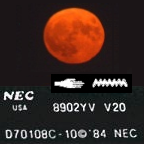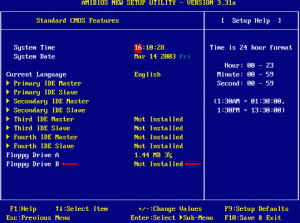Content Type
Profiles
Forums
Events
Everything posted by dencorso
-
@surfertje: When yours is the last post, do use the edit button to add new information, instead of posting endlessy replies to yourself. Or are you willingly bumping the thread? If so, do stop doing it so fast. And even when you do reply to anybody, yourself included, don't quote needlessy full posts: quote only the relevant part or don't quote at all. Please do behave.
-

How to Match USB Ports & Controllers?
dencorso replied to JorgeA's topic in Hard Drive and Removable Media
I bet you have one unused USB header connector in your motherboard. The USB header connectors are two parallel rows of 4 pins (or of 5 pins), to which a eight-hole connector should be attached (this connector would be at one end of a cable that, on the other end has the usual two retangular female Type-A USB connectors, usually mounted in a rear-bay bracket, like this one. The pinout is not exactly standard so it's necessary to compare the pin positions on the cable you eventually buy with that of the header (according to your motherboard manual) to see if the bracket cable can be used directly or if some of the connector pins must be moved around by hand. Download your motherboard manual and locate the USB headers in it. Then open the case and look for your actual header connectors and find out whether I'm right and there is one unused. If so, and in case you decide to put it to use, then I can discuss it in more detail. Changing subjects (well, not much): if your HDD is being detected as USB 1.1 in everyone of your USB ports, then something is wrong with its cable or, worse, with its internal USB controller. Try connecting it to another machine, whatever the OS it may have, just to see whether it also gets recognized as 1.1, and if so, change the cable. Any cable with the proper connectors will do, but a shielded one is best. BTW, which motherboard exactly do you use? I'd much like to look at its manual, too. -
Well, this being the case, you might as well test netapi32.dll v. 4.90.0.3000 (it is in WIN_13.CAB) in your machines. It might be the perfect compromise for running dmt.exe... Good luck!
-

Maximus-Decim Native USB Drivers
dencorso replied to maximus-decim's topic in Windows 9x Member Projects
When you do, test also whether, on booting to plain DOS the system with the pendrive inserted, it becomes accessible from DOS. -
Well, according to MDGx, in his 98SE2ME documentation: This is all I know about them. I use the 4.10.0.1998 versions of both.
-

How to Match USB Ports & Controllers?
dencorso replied to JorgeA's topic in Hard Drive and Removable Media
@JorgeA: Observe that if all ports are USB 2.0, you will have one EHC for all of them (at least) but also one UHC(or OHC) for each pair of ports. What decides whether the port wil behave as a USP 2.0 interface (and use the EHC) or as a USB 1.1 interface (and use the UHC/OHC) is dependent on how the device just plugged in is detected. And when a 2.0 device is improperly detected, the system falls back to 1.1, regarderless of the fact bothe the port and the device *are* 2.0! On the other hand, USBView numbers the ports consistently, so if you use a 1.1 device, such as a mouse, you can plug it into one port at a time and thus map the 1.1 port numbers to the physical port connectors in your machine. Doing likewise with a pendrive or any other 2.0 device will help you to find out the USBView numbers of the same physical port connectors. Each physical port connectors must map to two different numbers, one under the EHC and one under one UHC(or OHC). Now, if you have a USB 1.1 motherboard with a USB 2.0 add-on card, then things get some more complicated. @jaclaz: 70-80% relative humidity all year round... And the rain pours endlessy, too. -

How to Match USB Ports & Controllers?
dencorso replied to JorgeA's topic in Hard Drive and Removable Media
It can be poor electrical contact (due to oxidation or, more rarely, wear). Try the following: turn off the machine and unplug the power cable (if a desktop) or remove the battery (if a laptop/notebook). Then plug in fully and remove the usb cable (or device) from the port some twenty or thirty times in rapid succession, just to rub the contacts together (hopefully removing some oxidation from them). Remove the cable (or device) and turn on the machine again. After it finishes starting windows, plug the device/cable in again. Often you won't receive the "This USB device can perform faster if you connect it to a Hi-Speed USB 2.0 port." message again, at least for some time. -
Which newer version are you using? Didn't you just say it gave you an error?
-
But it was announced here, for those who looked for it. And, BTW, Win XP SP2 reached EOL yesterday, too (while XP SP3 will go on up to 04/08/2014). And cluberti is quite right: our last main source of updates is now dry.
-

Maximus-Decim Native USB Drivers
dencorso replied to maximus-decim's topic in Windows 9x Member Projects
That's wierd! Reboot again without a pendrive, then insert it and see what happens. Let's troubleshoot it. -
RLoew is right. All Via Win 9x/ME compatible SATA drivers *are* described as RAID drivers. This is the last version that works OK: SerialATA_V220E.zip (direct download). There may be others, from other manufacturers.
-
Right! In fact, so related that it ought to be a new reply, not a new thread. But this is easy to remedy: topics merged! And, BTW, I'm glad you succeeded, too!
-
I agree with Dave-H. KernelEx is the solution for using Opera above 10.54, and it's a pretty good one, at that. By now, in fact, more and more new programs (and new versions of familiar programs) will require KernelEx. Now, since you asked, no, downversioning ought not to work in this case, because new functionality *is* actually needed... new functionality that KernelEx actually provides.
-
Enough, both of you! No flamefests allowed here. Do behave yourselves!
-
BTW, are you really sure it *is* activated in the BIOS? I bet it isn't (see the red arrows in the attached picture). Try changing it to: 1.2 MB 5 1/4 Now, only in case it already is activated, then try adding a DRIVPARM=/D:1 /C /F:1 statement to CONFIG.SYS More info here
-
You did it! You solved it! The tray flickers no more! Way to go, Tihiy! You do rock, you really do! Thanks a whole lot! Sure! The tray is there to be used, of course!
-
It's not so easy, Queue! I use explorer.exe v. 4.72.3612.1710 and the tray flickers like crazy too! BTW, my systray.exe is v. 4.10.0.2224, for what it's worth.
-
Thanks! It's one of Boot-Land's emoticons... but it could be from anywhere else, too. You insert them by using image tags, like this (never mind the colors, code boxes are mad): [img=http://www.boot-land.net/forums/style_emoticons/default/roll1.gif] Enjoy!
-
With 3 GiB RAM *and* 512 MiB video RAM and SATA HDD, your only hope of running Win 98SE directly on your hardware would be by using RLoew's RAM Limitation Patch and his SATA patch, both of which are not for free (and may not be enough for your particular machine, but are worth testing). If this possibility interests you, you should consult him either by PM or by e-mail (findable at his site). If not, only by using a virtual machine you'll be able to run Win 98SE. There are no other options, as far as I know.
-

Need Help With Windows Updates That Won't Install
dencorso replied to highbids's topic in Windows XP
Thanks, Sp0iLedBrAt! I've tried installing them directly from the .msps, but that didn't work for me either. They do show under Add/Remove and say the install was successful, but, by comparing the versions of the files in the updates with those on the system, I've ascertained that KB976576, KB980773, KB979909 and KB976765 actually didn't install at all. There are reports elsewhere that not even the remove-.NET-and-reinstall trick works to solve this issue, so I decided not to attempt it. Instead, I installed manually KB980773, KB979909 and KB976765, by replacing just the executable files, and it worked, since Windows Update stopped offering me KB982168 and KB979909, but kept offering me KB982524 (because I hadn't installed KB976576, which is part of it). Now, KB976576, despite being marked NDP20SP2, actually contains files from the .NET Framework 4.0, which I hadn't installed in the system, so it wasn't possible to just update files which older versions didn't exist on the system. I then tried to install KB976576.msp once more, to no avail. Then I decided to install the optional update KB982670, which is the .NET Framework 4.0 Client Profile and contains all the files in KB976576 (plus other files), and that worked! On comparison, the files in KB982670 that also exist in (the QFE branch of) KB976576 have the exact same versions, and are the exact same executables, but contain newer Digital Signatures. And Windows Update stopped offering me KB982524, at long last! So, it was labor intensive, but this is the solution that worked for me. -
Since you lived without it up to now, I'd say wait for KernelEx 4.5 beta 3, which is due to be released shortly: ...Because of the added ability to deal with the latest Flash.
-
I have a working 1275 MB Seagate Medalist ST31277A (manufactured in 1997) stashed more for historical reasons than because of envisioning any use for it. Your comment prompted me to take it from the shelf and test it again, it's still working and pristine! Of course, as with all ATA-3 and older HDDs, the common PATA/USB adapter does not recognize it, so that the only way to test it is to actually connect it to a motherboard PATA controller. Seagate Medalist 1277 (ST31277A).pdf
-
Yeah... well, lack of LBA support hadn't crossed my mind, although it should, since we were discussing a similar case quite recently. Of course you're right, RLoew! So, Henrik, if you want more info on RLoew's products, visit this link. And for info on the various hardware limits to HDDs, visit this link.



